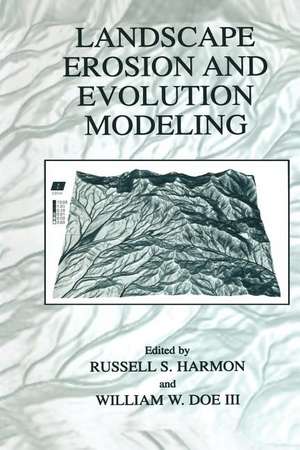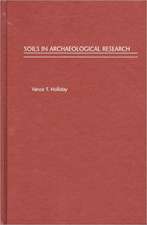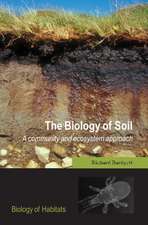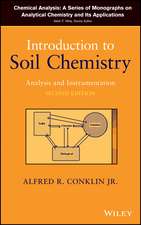Landscape Erosion and Evolution Modeling
Editat de Russell S. Harmon, William W. Doe IIIen Limba Engleză Paperback – 21 sep 2012
Landscape Erosion and Evolution Modeling is a state-of-the-art, interdisciplinary volume addressing the broad theme of soil erosion and landscape evolution modeling from different philosophical and technical approaches, ranging from those developed from considerations of first-principle soil/water physics and mechanics to those developed empirically according to sets of behavioral or empirical rules deriving from field observations and measurements. The validation and calibration of models through field studies is also included.
This volume will be essential reading for researchers in earth, environmental and ecosystem sciences, hydrology, civil engineering, forestry, soil science, agriculture and climate change studies. In addition, it will have direct relevance to the public and private land management communities.
| Toate formatele și edițiile | Preț | Express |
|---|---|---|
| Paperback (1) | 1229.58 lei 6-8 săpt. | |
| Springer Us – 21 sep 2012 | 1229.58 lei 6-8 săpt. | |
| Hardback (1) | 1234.77 lei 6-8 săpt. | |
| Springer Us – 31 dec 2001 | 1234.77 lei 6-8 săpt. |
Preț: 1229.58 lei
Preț vechi: 1499.49 lei
-18% Nou
Puncte Express: 1844
Preț estimativ în valută:
235.29€ • 246.78$ • 195.87£
235.29€ • 246.78$ • 195.87£
Carte tipărită la comandă
Livrare economică 01-15 aprilie
Preluare comenzi: 021 569.72.76
Specificații
ISBN-13: 9781461351399
ISBN-10: 1461351391
Pagini: 568
Ilustrații: XXIII, 540 p.
Dimensiuni: 155 x 235 x 30 mm
Greutate: 0.79 kg
Ediția:2001
Editura: Springer Us
Colecția Springer
Locul publicării:New York, NY, United States
ISBN-10: 1461351391
Pagini: 568
Ilustrații: XXIII, 540 p.
Dimensiuni: 155 x 235 x 30 mm
Greutate: 0.79 kg
Ediția:2001
Editura: Springer Us
Colecția Springer
Locul publicării:New York, NY, United States
Public țintă
ResearchCuprins
1. Introduction to Soil Erosion and Landscape Evolution Modeling.- 1. Soil Erosion Management and Model Development.- 2. Soil Erosion Processes.- 3. Models and Modeling Approaches.- 4. Linking Reality and Modeling.- Acknowledgements.- References.- 2. Erosion Problems on U.S. Army Training Lands.- 1. Introduction.- 2. Regulatory Controls.- 3. Plant Material Development and Use on Military Lands.- 4. Physical Erosion and Sediment Controls.- 5. Applying Science in Erosion and Sediment Control.- References.- 3. Effects of Freeze-Thaw Cycling on Soil Erosion.- 1. Introduction.- 2. Effects of Soil Freeze-Thaw Cycling.- 3. Summary and Conclusions.- 4. Future Research Needs.- Acknowledgements.- References.- 4. Determination of Slope Displacement Mechanisms and Causes.- 1. Introduction.- 2. Bluff Geometry and Stratigraphy.- 3. Ground Water Conditions.- 4. Soil Characteristics.- 5. Slope Displacement Monitoring Methods.- 6. Displacement Models.- 7. Causes of Displacement.- 8. Processes of Bluff Failure.- 9. Limit Equilibrium Analyses.- 10. Conclusions.- Acknowledgements.- References.- 5. Using Cosmogenic Nuclide Measurements in Sediments to Understand Background Rates of Erosion and Sediment Transport.- 1. Introduction.- 2. Methods.- 3. Cosmogenic Nuclide Systematics and Interpretative Models.- 4. Case Studies.- 5. Implications Of Sediment Cosmogenic Nuclide Measurements.- Acknowledgements.- References.- 6. Erosion Modeling.- 1. Introduction.- 2. Empirical Models.- 3. Process-Based Models.- 4. Model Testing.- 5. Model Validation.- 6. Model Application.- 7. Conclusions.- References.- 7. The Water Erosion Prediction Project (WEPP) Model.- 1. Introduction.- 2. WEPP Model Development History.- 3. WEPP Hillslope Model Component.- 4. WEPP Model Watershed Component.- 5. Model ValidationStudy Results.- 6. Data and Model Uncertainty: Impacts on Model Evaluation and Application.- 7. WEPP Model Status and Current Activities.- References.- 8. A Simulation Model for Erosion and Sediment Yield at the Hillslope Scale.- 1. Introduction.- 2. Review of Erosion and Sediment Yield Modeling at the Hillslope Scale.- 3. Development of the Hillslope Erosion Model.- 4. Calibration and Validation of the Hillslope Erosion Model.- 5. Applications of the Hillslope Erosion Model at the Fort Carson Military Reservation and the Pinon Canyon Maneuver Site.- 6. Discussion and Summary.- 7. Conclusions.- References.- 9. Waterbots.- 1. Introduction.- 2. The Waterbot Model.- 3. Hillslope Diffusion.- 4. Bedrock Erosion.- 5. Weathering.- 6. Other Landscape Transport Processes.- 7. Nonlinear Effects.- 8. Contributing Area and Hydrographs.- 9. Example - Setting up the DEM and Raining on the Black Mountains.- 10. Dimensionless Numbers in the Black Mountains.- 11. The Case of Gower Gulch: A Change in Flow Regime.- 12. Summary.- Acknowledgements.- References.- 10. Two-Dimensional Watershed-Scale Erosion Modeling with CASC2D.- 1. Introduction.- 2. Hydrologic/Erosion Model CASC2D.- 3. USD A-ARS Goodwin Creek Experimental Watershed.- 4. Calibration of CASC2D Erosion Parameters on Goodwin Creek.- 5. Erosion Model Performance.- 6. Discussion.- 7. Conclusions.- Acknowledgements.- References.- 11. Multiscale Soil Erosion Simulations for Land Use Management.- 1. Introduction.- 2. Methods.- 3. Simplified Special Cases and Model Extensions.- 4. Landscape Scale Erosion Prevention Planning and Design.- 5. Conclusions.- Acknowledgements.- References.- 12. The Channel-Hillslope Integrated Landscape Development Model (CHILD).- 1. Introduction.- 2. Background.- 3. Model Formulation.- 4. Discussion: Application and Limitations.- 5. Summary and Conclusions.- Acknowledgements.- References.- 13. Simulation of Streambank Erosion Processes with a Two-Dimensional Numerical Model.- 1. Introduction.- 2. Theoretical Analysis.- 3. Numerical Simulation.- Summary.- Acknowledgements.- References.- 14. Spatial Analysis of Erosion Conservation Measures with LISEM.- 1. Introduction.- 2. LISEM Theoretical Framework.- 3. Integration into a Raster GIS.- 4. Wheel Tracks and Tillage Networks.- 5. A Case Study: Grass Strips and Tillage Direction in the Netherlands.- References.- 15. Numerical Simulation of Sediment Yield, Storage, and Channel Bed Adjustments.- 1. Introduction.- 2. Model Equations.- 3. Numerical Simulation.- 4. Initial and Transient Boundary Conditions.- 5. Simulation Results.- 6. Conclusions.- References.- 16. The Limits of Erosion Modeling.- 1. Introduction.- 2. The Policy Context of Model Development and Use.- 3. Case Studies.- 4. Conclusions.- Acknowledgements.- References.- 17. Envisioning a Future Framework for Managing Land and Water Resources.- 1. Introduction.- 2. Use of Technology in Resource Management - Today.- 3. Major Aquatic Ecosystems.- 4. Development of the Land Management System.- 5. Summary.
Recenzii
`In summary, this volume provides an excellent reference book on the state of current erosion modelling, and should be required reading on that topic, including the historical summary and the final review.'
The Holocene, 13:5 (2003)
The Holocene, 13:5 (2003)












